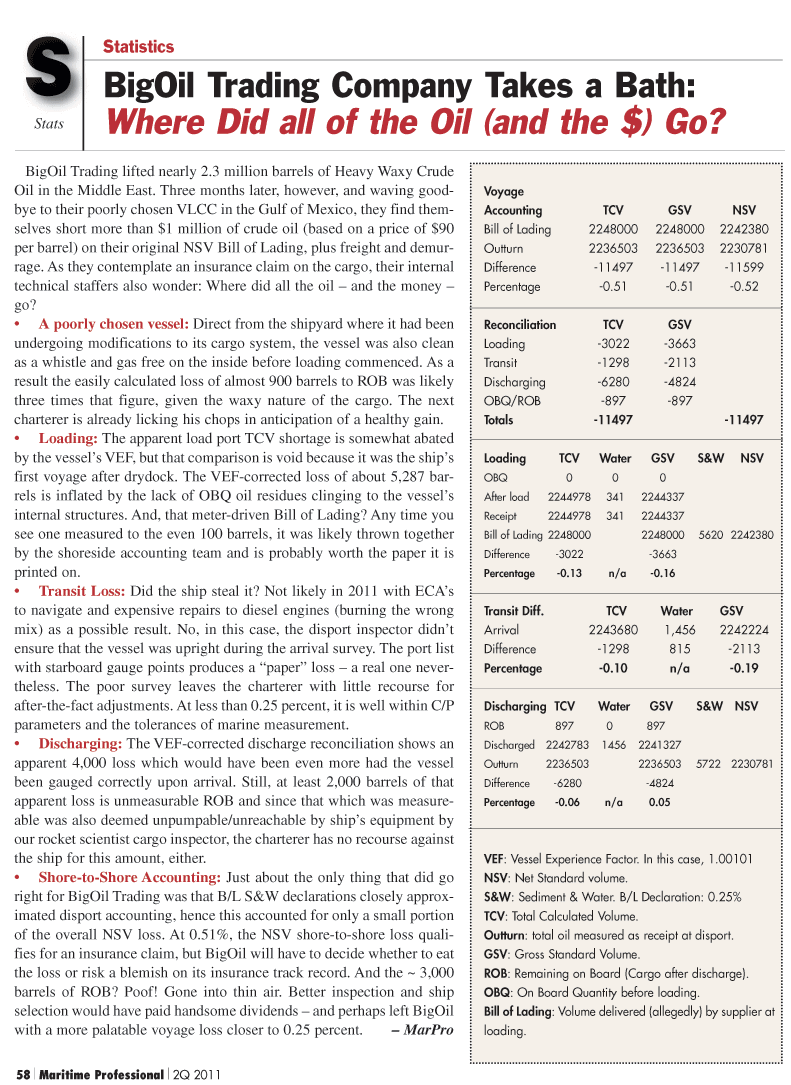
Page 58: of Maritime Logistics Professional Magazine (Q2 2011)
Energy Transportation
Read this page in Pdf, Flash or Html5 edition of Q2 2011 Maritime Logistics Professional Magazine
58 Maritime Professional 2Q 2011
S
Stats
BigOil Trading Company Takes a Bath:
Where Did all of the Oil (and the $) Go?
Statistics
BigOil Trading lifted nearly 2.3 million barrels of Heavy Waxy Crude
Oil in the Middle East. Three months later, however, and waving good- bye to their poorly chosen VLCC in the Gulf of Mexico, they find them- selves short more than $1 million of crude oil (based on a price of $90 per barrel) on their original NSV Bill of Lading, plus freight and demur- rage. As they contemplate an insurance claim on the cargo, their internal technical staffers also wonder: Where did all the oil – and the money – go? • A poorly chosen vessel: Direct from the shipyard where it had been undergoing modifications to its cargo system, the vessel was also clean as a whistle and gas free on the inside before loading commenced. As a result the easily calculated loss of almost 900 barrels to ROB was likely three times that figure, given the waxy nature of the cargo. The next charterer is already licking his chops in anticipation of a healthy gain. • Loading: The apparent load port TCV shortage is somewhat abated by the vessel’s VEF, but that comparison is void because it was the ship’s first voyage after drydock. The VEF-corrected loss of about 5,287 bar- rels is inflated by the lack of OBQ oil residues clinging to the vessel’s internal structures. And, that meter-driven Bill of Lading? Any time you see one measured to the even 100 barrels, it was likely thrown together by the shoreside accounting team and is probably worth the paper it is printed on. • Transit Loss: Did the ship steal it? Not likely in 2011 with ECA’s to navigate and expensive repairs to diesel engines (burning the wrong mix) as a possible result. No, in this case, the disport inspector didn’t ensure that the vessel was upright during the arrival survey. The port list with starboard gauge points produces a “paper” loss – a real one never- theless. The poor survey leaves the charterer with little recourse for after-the-fact adjustments. At less than 0.25 percent, it is well within C/P parameters and the tolerances of marine measurement. • Discharging: The VEF-corrected discharge reconciliation shows an apparent 4,000 loss which would have been even more had the vessel been gauged correctly upon arrival. Still, at least 2,000 barrels of that apparent loss is unmeasurable ROB and since that which was measure- able was also deemed unpumpable/unreachable by ship’s equipment by our rocket scientist cargo inspector, the charterer has no recourse against the ship for this amount, either. • Shore-to-Shore Accounting: Just about the only thing that did go right for BigOil Trading was that B/L S&W declarations closely approx- imated disport accounting, hence this accounted for only a small portion of the overall NSV loss. At 0.51%, the NSV shore-to-shore loss quali- fies for an insurance claim, but BigOil will have to decide whether to eat the loss or risk a blemish on its insurance track record. And the ~ 3,000 barrels of ROB? Poof! Gone into thin air. Better inspection and ship selection would have paid handsome dividends – and perhaps left BigOil with a more palatable voyage loss closer to 0.25 percent. – MarPro
Voyage
Accounting TCV GSV NSV
Bill of Lading 2248000 2248000 2242380
Outturn 2236503 2236503 2230781
Difference -11497 -11497 -11599
Percentage -0.51 -0.51 -0.52
Reconciliation TCV GSV
Loading -3022 -3663
Transit -1298 -2113
Discharging -6280 -4824
OBQ/ROB -897 -897
Totals -11497 -11497
Loading TCV Water GSV S&W NSV
OBQ 0 0 0
After load 2244978 341 2244337
Receipt 2244978 341 2244337
Bill of Lading 2248000 2248000 5620 2242380
Difference -3022 -3663
Percentage -0.13 n/a -0.16
Transit Diff. TCV Water GSV
Arrival 2243680 1,456 2242224
Difference -1298 815 -2113
Percentage -0.10 n/a -0.19
Discharging TCV Water GSV S&W NSV
ROB 897 0 897
Discharged 2242783 1456 2241327
Outturn 2236503 2236503 5722 2230781
Difference -6280 -4824
Percentage -0.06 n/a 0.05
VEF: Vessel Experience Factor. In this case, 1.00101
NSV: Net Standard volume.
S&W: Sediment & Water. B/L Declaration: 0.25%
TCV: Total Calculated Volume.
Outturn: total oil measured as receipt at disport.
GSV: Gross Standard Volume.
ROB: Remaining on Board (Cargo after discharge).
OBQ: On Board Quantity before loading.
Bill of Lading: Volume delivered (allegedly) by supplier at loading.

 57
57

 59
59
